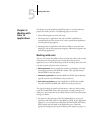
5
5-1 Working with color
This chapter provides guidelines for defining colors in your documents to
produce the results you want. The following topics are covered:
• Factors affecting how you work with color
• Choosing colors in applications that rely on GDI or QuickDraw to
communicate data to the printer driver, such as presentation applications
and word processing programs
• Choosing colors in applications that have the ability to write their own
PostScript, such as some page-layout programs, illustration programs, and
pixel-editing applications
Working with color
The two main factors that influence how you work with color in the creation
of documents are the application you use and the final print device.
Applications vary in the methods they provide for choosing colors and in the
way they transmit color data to the print device.
• Office applications such as presentation software, spreadsheets, and word
processing programs use the RGB color model. They typically transmit
only RGB data to the print device.
• Illustration applications use both the RGB and CMYK color models but
typically transmit only CMYK data to the print device.
• Pixel-editing applications use both the RGB and CMYK color models.
They also transmit both RGB and CMYK data to the print device.
The type of printing you plan for the document—short-run color printing
on the iR C2100/2100S versus color printing for eventual printing on an
offset press—determines the way you define colors as well as the print option
settings you choose.
• For short-run color printing on the iR C2100/2100S, use any type of
application and define colors in either RGB or CMYK. If your application
supports it, you can also choose colors from the PANTONE color library.
Placed images may be limited to the RGB color space. Choose the
appropriate settings for print options affecting color output (see page 1-1).
Chapter 5:
Working with
Color in
Applications


















